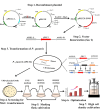Engineering Pichia pastoris for the efficient production of the high-value steroid intermediate 15α-OH-D-ethylgonendione
- PMID: 40685341
- PMCID: PMC12278525
- DOI: 10.1186/s12934-025-02796-9
Engineering Pichia pastoris for the efficient production of the high-value steroid intermediate 15α-OH-D-ethylgonendione
Abstract
15α-OH-D-ethylgonendione (15α-OH-DE) is a key intermediate for the synthesis of steroid drug gestodene, a major component of a new generation of powerful contraceptives. Synthetic access to 15α-OH-DE by chemical means is limited by low titers and generation of toxic byproducts. To develop a sustainable process for 15α-OH-DE production, a whole-cell catalyst was constructed by engineering Pichia pastoris co-overexpressing the PRH gene from filamentous fungus Penicillium raistrickii, which encodes a steroid 15α-hydroxylase capable of selectively 15α-hydroxylating DE, and the glucose-6-phosphate dehydrogenase gene ZWF1 from the baker's yeast for enhanced NADPH production. Shake-flask cultivation was performed to optimize fermentation parameters and assess the potential of the engineered P. pastoris strains for 15α-OH-DE production. Subsequently, production was scaled up using a fed-batch strategy in a 5-L stirred-tank bioreactor, with pure methanol serving as both the carbon source and inducer. This process achieved a product titer of 5.79 g L⁻¹ with DE feeding of 10 g L- 1 after 170 h of methanol feeding (196 h fermentation), representing the highest reported titer of 15α-OH-DE to date. The above results highlight the potential of developing P. pastoris-based biotransformation systems for the efficient production of key intermediates of steroid pharmaceuticals and other high-value fine chemicals.
Keywords: Pichia pastoris; D-ethylgonendione; Fed-batch fermentation; Glucose-6-phosphate dehydrogenase; Intermediate; Steroid 15α-hydroxylase.
© 2025. The Author(s).
Conflict of interest statement
Declarations. Ethics approval and consent to participate: Not applicable. Consent for publication: All authors consent to the publication of this manuscript in its submitted form. Competing interests: The authors declare no competing interests.
Figures









References
-
- Wang H, Abe I. Recent developments in the enzymatic modifications of steroid scaffolds. Org Biomol Chem. 2024;22:3559–83. - PubMed
-
- Donova MV, Egorova OV. Microbial steroid transformations: current state and prospects. Appl Microbiol Biotechnol. 2012;94:1423–47. - PubMed
-
- Stanczyk FZ, Archer DF. Gestodene: a review of its pharmacology, potency and tolerability in combined contraceptive preparations. Contraception. 2014;89:242–52. - PubMed
-
- Irrgang S, Schlosser D, Fritsche W. Involvement of cytochrome P-450 in the 15α-hydroxylation of 13-ethyl-gon-4-ene-3, 17-dione by Penicillium raistrickii. J Steroid Biochem Molec Biol. 1997;60:339–46. - PubMed
-
- Schlosser D, Irrgang S, Schmauder H. Steroid hydroxylation with free and immobilized cells of Penicillium raistrickii in the presence of β-cyclodextrin. Appl Microbiol Biotechnol. 1993;39:16–20. - PubMed
MeSH terms
Substances
Supplementary concepts
Grants and funding
LinkOut - more resources
Full Text Sources

